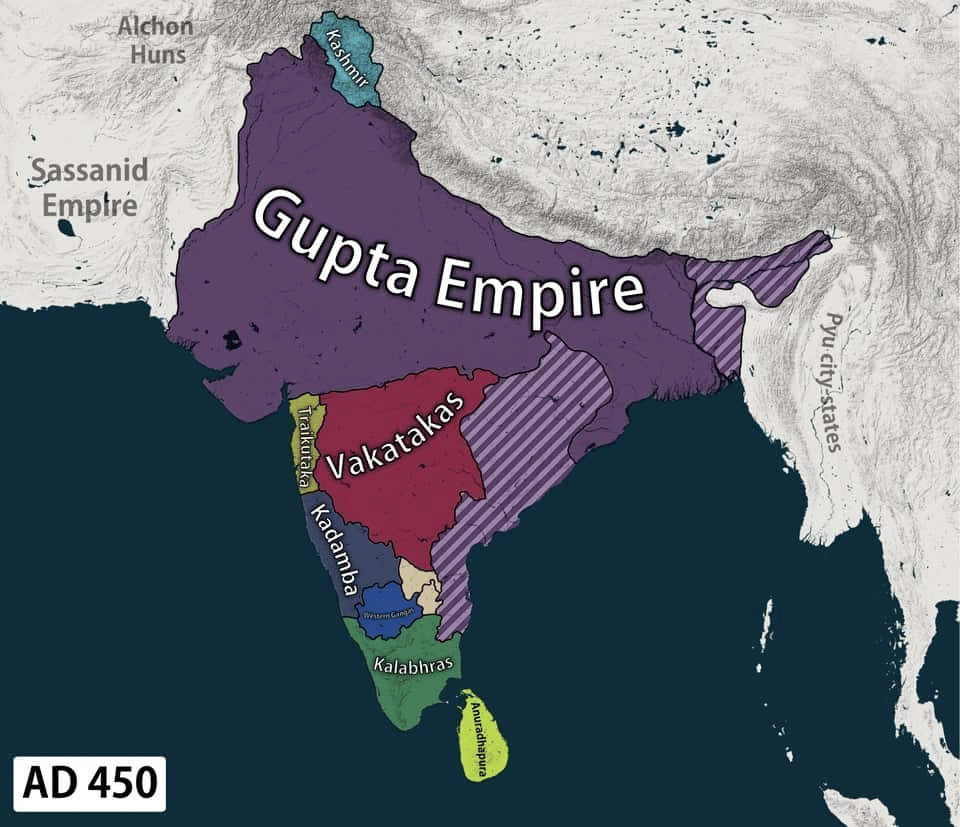CTET & State TET Exam > CTET & State TET Notes > Social Studies & Pedagogy Paper 2 for CTET & TET Exams > Notes: Political Development
Notes: Political Development | Social Studies & Pedagogy Paper 2 for CTET & TET Exams - CTET & State TET PDF Download
In the 4th century AD a new dynasty, the Guptas, arose in Magadh and established a large kingdom over the greater part of Northern India. This period is referred as the ‘classical age’ or ‘golden age’ of ancient India. Towards the beginning of 6th century, Vardhana dynasty was founded at Thaneshwar. Harshavardhana became a famous ruler of this dynasty.

Gupta Dynasty
- The Gupta dynasty was founded by Srigupta in the 3rd century AD.
- Chandragupta I was the first great ruler of the Gupta dynasty, adopting the grand title of Maharaja Adhiraja.
- Samudragupta succeeded Chandragupta I and ruled from AD 335 to 380. He was known as the Indian Napolean due to his extensive military conquests.
- Samudragupta's Prashasti, composed by his court poet Harisena, praised the king for his victories and qualities, inscribed on the Ashokan pillar at Allahabad.
- The Prashasti described four types of rulers and Samudragupta's policies towards them, including those uprooted, defeated but allowed to rule again, tributaries, and those who submitted.
- Samudragupta's coins depicted various aspects of his rule, such as playing the veena.
- Important centers of Gupta rule included Prayaga (Allahabad), Ujjain, and Pataliputra (Patna).
- Samudragupta was succeeded by Chandragupta II, under whom the famous poet Kalidasa flourished.
Vardhana Dynasty
- The Pushyabhuti dynasty, also known as the Vardhana dynasty, ruled parts of Northern India during the 6th and 7th centuries.
- Harshavardhana, the last ruler of the dynasty, ruled from 606 CE to 647 CE and was a significant ruler of India.
- Harshavardhana's biography, the Harshacharita, was written by his court poet Banabhatta in Sanskrit.
- Harshavardhana's reign was also documented by the Chinese traveler Xuanzang, who spent time at his court.
- Harshavardhana conquered Magadha and Bengal but was stopped by Pulakeshin II of the Chalukya dynasty from advancing into the Deccan.
Question for Notes: Political DevelopmentTry yourself: Who was known as the Indian Napoleon due to his extensive military conquests?View Solution
Gupta Administration
Central Administration
- The king, although possessing extensive powers, ruled with the assistance of a Council of Ministers and various civil officials.
- The most important officers in the Gupta empire were the Kumaramatyas.
- The royal seal bore the imprint of Garuda, and the practice of granting land and fiscal administrative concessions to priests and administrators began in the Gupta era.
- The office of Sandhivigrahaka, minister of peace and war, was introduced under Samudragupta, with Harisena holding this title.
Provincial and Local Administration
- The empire was divided into Bhuktis headed by Uparika, Bhuktis into districts called Vishayas headed by Vishyapati, Vishayas into Vithis, and Vithis into villages.
City Administration
- Paura was responsible for city administration, comprising the President of the city corporation, chief representative of the guild of merchants, a representative of the artisans, and the Chief Accountant.
- Unlike the Mauryas, the city committee under the Guptas was not appointed by the government but comprised local representatives.
The document Notes: Political Development | Social Studies & Pedagogy Paper 2 for CTET & TET Exams - CTET & State TET is a part of the CTET & State TET Course Social Studies & Pedagogy Paper 2 for CTET & TET Exams.
All you need of CTET & State TET at this link: CTET & State TET
|
75 videos|311 docs|77 tests
|
FAQs on Notes: Political Development - Social Studies & Pedagogy Paper 2 for CTET & TET Exams - CTET & State TET
| 1. What were the key characteristics of the Gupta Dynasty? |  |
Ans. The Gupta Dynasty was known for its political stability, economic prosperity, advancements in art and architecture, and support for Hinduism and Buddhism.
| 2. How did the Vardhana Dynasty contribute to the political development of ancient India? |  |
Ans. The Vardhana Dynasty played a significant role in the political landscape of ancient India by expanding their empire through military conquests and establishing strong administrative systems.
| 3. What were some of the key administrative practices of the Gupta Dynasty? |  |
Ans. The Gupta Dynasty implemented a decentralized administrative system, with local rulers managing their territories under the overall authority of the Gupta kings. They also had a well-organized bureaucracy to govern their empire effectively.
| 4. How did the Gupta Dynasty influence the cultural and intellectual development of ancient India? |  |
Ans. The Gupta Dynasty was a period of great cultural and intellectual flourishing in India, with advancements in mathematics, science, literature, and art. They also supported the growth of Hinduism and Buddhism during their reign.
| 5. What were the major achievements of the Gupta Administration in ancient India? |  |
Ans. The Gupta Administration is known for its efficient tax collection system, promotion of trade and commerce, and the establishment of a network of roads and irrigation systems. They also had a strong military that helped maintain peace and stability in the empire.
Related Searches
















